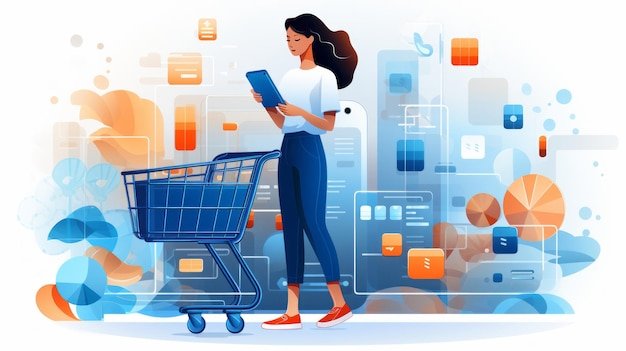How to effectively manage purchases and customers in your business
-
Anna Voloshko
Copywriter Elbuz
How to learn to control the desires of customers and turn their spontaneous purchases into your conscious decisions to earn money? How to attract customers to your brand and increase conversion? In this article, you'll learn strategies and techniques for managing impulse purchases that will help you attract and retain impulse customers. Now, together with you, we will plunge into the exciting world of financial success and learn how to effectively manipulate spontaneous purchases so that your business flourishes. Don't miss the chance to take control of your financial situation and achieve great results!

Glossary
- impulse purchases are purchases made without prior planning or thought. They are usually based on impulse or sudden need.
- impulsive customers are customers who tend to make spontaneous purchases, often under the influence of emotions or external influences.
- Impulse Buying Management Strategies are methods and techniques that help companies increase conversion among impulse customers and manage their tendency to buy spontaneously.
- Impulsive Customer Conversion Techniques are approaches that are used to encourage impulsive customers to make purchases and increase the likelihood of them converting.
- framing effect is a technique in which an offer or product is presented within the framework of favorable conditions or offers to attract attention and encourage purchase.
- nonverbal communication techniques are methods of communicating with clients that are used to evoke an emotional response and build trust without using verbal expressions.
- shopping simplification is a strategy that relies on simplifying the checkout process so that customers can complete their purchase quickly and easily.
- more pleasure, less pain is the principle that companies try to make the shopping experience enjoyable and easy for customers in order to reduce negative emotions and increase customer satisfaction .
How I learned to effectively manage spontaneous purchases and clients
Is it possible to learn to control your purchases and make informed decisions? I can say with confidence - yes. Over the years, I have faced the challenges of sales management and realized that some buyers make decisions automatically, driven by impulses. But I developed strategies and techniques that allowed me to increase my conversion and sales effectiveness. Today I want to share my knowledge and experience with you.

How the implicit decision-making system works
The implicit decision-making system is a kind of autopilot . We often don't think about our actions and make decisions automatically. For example, when we get out of bed in the morning or make coffee. The implicit system works very deeply and covers even the more complex areas of our lives.
Let's consider the example of driving a car. Remember your first trips on dirt roads? All these difficulties and fears when it seemed that you would never learn to drive normally. But over time, the implicit system learned the necessary skills, and today you drive without thinking. It's just that your decisions are controlled by autopilot.
This is exactly how the decision-making system works in everyday life and purchases. We make decisions instantly, based on intuition, and often give in to impulse.
Operating principle of the explicit decision-making system
The explicit decision-making system is activated in complex and non-standard situations. If you compare it with driving a car, it is as if you went to an unfamiliar city. You need to focus on the path, pay attention to road signs and make decisions consciously.
Similarly, in shopping, an explicit system allows the buyer to make informed decisions. But how can you learn to control this process and increase conversion?

My strategies and methods for managing impulse purchases
I have learned from my own experience that there is several effective strategies and methods that will help us control our spontaneous sales and increase conversion among impulsive customers. Here are some of them:
Encouragement and stimulation. The most important thing for customers is to create incentives and encourage them to buy. Promotions and special offers can be a direct impetus for the purchasing decision.
It is important to understand that each person is different, and these strategies and techniques can be tailored to suit your needs and goals. However, always remember that impulsive decisions can affect their rational thinking.
Summary
Controlling spontaneous purchases and managing impulsive customers is possible if you use the right strategies and techniques. I learned to identify my own needs, compare offers, and make smart decisions. Today I can tell you with confidence: taking control of your purchases is possible, and you will be able to increase your conversion and sales efficiency.
If you want to learn more, I invite you to check out our promotion! PROMOTION!!!
How to manage impulse purchases
In this section I would like to share my experience and tell about strategies that will help you effectively manage spontaneous sales and increase conversion among impulsive customers.
Offer a ready-made solution
One of the key ways to help a person make a decision and make a purchase is to offer a ready-made option. You've probably noticed that stores often highlight certain products or services that are on sale or are new. This is no coincidence.
We are all familiar with the situation when we come for a certain product and see that a huge bright “SPECIAL” price tag is attached to a number of ordinary bags and cans. Even if we don’t know whether the promotion is really happening or this product can be bought somewhere else cheaper, our attention is riveted to this offer. Thus, we no longer choose among all available products, but compare the promotional and regular options. The choice becomes much easier, and the client feels that you are offering him a ready-made solution.
Similar tactics can be used in online stores. For example, you can highlight a product on your site as new or highlight it with a bright card. The main thing is to make sure that this product immediately catches the buyer’s eye.

Important: Offer ready-made solutions and focus on important offers to simplify the client's choice.
Use the framing effect
Let's move on to the next strategy that will help you manage spontaneous purchases - the framing effect. This technique is based on the psychological characteristics of information perception.
A famous experiment with a cosmetics company showed that product framing can greatly influence consumer perception. A series of tests was conducted where some of the participants saw a neutral jar without any markings, and the other part saw a jar with a logo and brand name. The results showed that framed boxes generated more positive emotions and greater engagement among consumers.
This effect can be used in sales. Of course, in this case we are not talking about gluing eyes to products, as in the experiment with a box of chocolates. But you can use satisfied customers as a frame for your products or services. Placing the faces of people who are happy with their purchase on your site will give potential customers a sense of positive reactions from others and increase the likelihood of impulse purchases.

Tip: Use a frame effect to create a positive impression consumers about your product or service.
Use non-verbal communication techniques
Another way to manage spontaneous purchases is to use non-verbal communication techniques. Such methods are based on influencing brain activity and subconscious perception of the consumer.
A psychological experiment conducted by neuroscientists confirmed that the faces of satisfied customers have a positive impact on purchasing decisions. There were a series of studies done where people were shown a donation box, and in some cases the box had eyes on it. The results showed that the presence of eyes caused more responsible behavior and greater generosity in consumers.
You can use this technique in your sales too. You shouldn't put eyes on your website, but you can use photos of happy customers to show potential buyers how positive they feel after purchasing your product or service.

Recommendation: Influence customers' subconscious perceptions using non-verbal handling techniques and images of satisfied customers.
Make the purchasing process as easy as possible
An important aspect of successfully managing impulse purchases is the ease of the purchasing process. The concept of user experience (UX) has become an integral part of modern online shopping. The goal is to simplify the user’s path on the site as much as possible and make it easier for him to make a purchasing decision.
According to research, for a customer to make a purchase, he only needs to take three simple steps. If the path is more confusing and requires more clicks, the customer may lose interest and leave your site. Make menus, buttons and interface convenient and intuitive. Remember that for most users, familiar templates and interface elements will be more attractive and easier to use.
.gif)
Tip: Provide users with a simple and clear purchasing process, their comfort and confidence in choosing a product.
More pleasure, less suffering
To conclude this section, I would like to talk about an experiment that neuroscientists conducted. The results showed that the purchasing decision is a battle between two parts of the brain. One is responsible for pleasure, and the other is responsible for suffering.
To manage impulse buying, it is important to increase pleasure and reduce pain. Various methods can be used for this. For example, increasing the value of a product or service through the framing effect, proper positioning and packaging. As well as reducing suffering by offering discounts or attractive conditions.
Recommendation: Increase the value of a product or service, create a positive experience in customers and reduce their pain in making a purchasing decision.
I hope these strategies will help you effectively manage impulse purchases and increase conversions among impulse customers. If you liked this section, don't forget to share it with your colleagues and bookmark it for later.

If you have any additional questions or would like more information, please contact us. I am always ready to share my experience and knowledge.
Marketing Hacking: Managing Impulse Purchases to Increase Conversions
Knowledge That Gave Me an Edge Over the Competition
As a marketer with many years of experience in the retail industry, I was faced with the situation of managing spontaneous purchases and impulsive customers. In my practice, I have applied a huge number of strategies and methods that allowed me to manage these factors as effectively as possible and increase conversion. In this section, I want to share my experience with you and talk about how you can manage spontaneous purchases as effectively as possible and attract impulsive customers.
Incentivizing Impulse Buying: How I Made It Possible
When it comes to impulse buying, one of the key challenges is to create incentives that motivate customers to buy immediately . I did my research and found several effective strategies that have proven successful in my practice.
1. Create Limited Offers
One of the most powerful ways to encourage impulse buying is to create a limited offer. I have actively used this strategy in my projects and received excellent results. For example, I offered a discount on products only to the first 100 customers or a limited number of products at a promotional price. This approach creates a sense of urgency and motivates customers to buy now.

2. Personalize Offers
Another powerful tool I've used is personalization proposals. Based on data about customer behavior and their preferences, I adapted offers so that they best suit the interests of customers. For example, I offered clients promotions and discounts on products that were a continuation of their previous purchases. This approach increases the likelihood of spontaneous purchases and satisfies customer needs.
3. Creating Attractive Showcases and Displays
The visual aspect plays an important role in encouraging impulse purchases. I have used this tool extensively to create eye-catching displays in my stores. I selected bright and attractive design elements that attracted the attention of clients and motivated them to make a purchase. For example, I placed products on promotional displays with a special color to attract the attention of customers and arouse their interest.
4. Using Social Proof
Social proof is a powerful tool that helps attract impulsive customers and increase their likelihood of purchasing. I actively used testimonials from satisfied customers, referrals from friends, and visual evidence of customer satisfaction to convince other customers to make a purchase. For example, I added a review block on the site, and also placed posters with positive customer reviews next to promotional products. This approach created trust and motivated customers to make a purchase.
Summary
Managing spontaneous purchases and impulsive customers is a challenging task, but with the right strategies and techniques, it is possible. I have studied this topic in depth, applied various approaches in my practice and achieved impressive results. I am confident that by using these strategies and techniques, you will be able to take impulse buying to the next level and significantly increase conversion among impulse customers.
"Success is the ability to manage the flow of impulse purchases and make them profitable for your business." - Phil Barden, popular writer and talented marketer with a worldwide reputation.
Now that you know some of the secrets to successfully managing impulse purchases, you're ready to put them into practice and increase your efficiency of your business. Don't be afraid to experiment, adapt and improve your strategies - this is the key to success. Continue to the next section to learn more about increasing conversion and sales effectiveness.

Reviews: an important factor in increasing conversion
Reviews play an important role in persuading potential customers in purchase. Using positive reviews and recommendations allows you to build trust among impulsive buyers and increase conversion. Post reviews on your website, social media, and other platforms to give customers the opportunity to share their positive experiences.
Learn more about how to collect and work with reviews for your online store. This article will provide you with additional strategies and guidelines to help you make the most of reviews in your business.
![]()
Conclusion
Managing spontaneous purchases and increasing conversion among impulsive customers are key marketing challenges . I have done research and formed my own strategies and techniques that have helped me succeed in this field. I believe that using limited offers, personalization, creating attractive storefronts and displays, and social proof will help you effectively manage impulse purchases and increase conversions.
Don't be afraid to experiment, adapt and improve your strategies according to market trends and customer needs. And remember that success comes only to those who actively apply the acquired knowledge and strive for constant development.

Frequently asked questions on “How to effectively manage spontaneous purchases and impulsive customers”
- What strategies can help manage impulse purchases in business?
- You can manage impulse buying with the following strategies:
- Use framing in your marketing
- Adopt non-verbal communication techniques
- Simplify the purchasing process - How to increase conversion among impulsive customers?
- To increase the conversion of impulsive customers:
- Offer a ready-made solution that will satisfy their needs
- Create positive emotions and greater shopping pleasure
- Simplify the checkout process - How does the framing effect work to manage impulse purchases?
- The framing effect is a psychological technique that involves contextually presenting a product or service in a more favorable light. This effect can attract customers' attention and encourage them to make spontaneous purchases.
- What nonverbal communication techniques will help manage spontaneous purchases?
- Some non-verbal communication techniques that can help manage impulse buying include using attractive packaging designs, bright colors and attractive fonts, and creating emotional connections with product or service.
- How to simplify the purchasing process for spontaneous customers?
- Simplifying the purchasing process for spontaneous customers can be achieved using the following methods:
- Optimizing the interface and navigation on the site
- One-click checkout
- Fast delivery and easy returns - How to increase shopping pleasure and reduce pain ?
- To enhance your shopping experience and reduce your pain:
- Provide high quality product or service
- Provide warranties and opportunities for feedback
- Notify the client about the delivery status - Is there a ready-made solution for managing spontaneous purchases?
- Yes, there are ready-made solutions and strategies to help manage impulse purchases. However, each business must choose appropriate methods based on its audience and the characteristics of the product or service.
- What other factors can influence the spontaneity of a purchase?
- Some additional factors that may influence the spontaneous purchase include:
- Price and discounts
- Limited quantity of product or services
- Promotions
- Recommendations and reviews from other customers - Can effectively managing impulse purchases lead to increased customer conversions?
- Yes, effectively managing impulse purchases can lead to increased customer conversions. By offering attractive terms and making the purchasing process easier, you can encourage impulsive customers to make a purchasing decision.
- Are there any special orientations to managing impulsive clients?
- Yes, managing impulsive customers can be guided by specific guidelines such as:
- Providing enough information about the product or service to so that the client can make his decision as quickly as possible
- Demonstration of advantages and key features that may interest an impulsive client
🌟Thank you for reading this article!🌟
Now that you've reached the end, you've become a true expert in managing impulse purchases and dealing with impulsive customers. You realized that in these fast-paced, dynamic worlds there was a whole universe of possibilities.
Concerned about your success and desire to manage impulse purchases as effectively as possible, I shared with you strategies, methods and my own experiences. I hope you find them useful and are able to put your new knowledge into practice.
Now that you're ready to apply these strategies in real life, I invite you to share your thoughts and successes in the comments below. Let's create even more effective ways to work with clients together!
Feel free to ask questions or discuss your ideas. After all, each of us has something unique to bring to this fun and unpredictable game.
Thank you for your support and confidence in this exciting journey!
With love,
Independent expert in managing spontaneous purchases and impulsive customers

- Glossary
- How I learned to effectively manage spontaneous purchases and clients
- How to manage impulse purchases
- Marketing Hacking: Managing Impulse Purchases to Increase Conversions
- Reviews: an important factor in increasing conversion
- Frequently asked questions on “How to effectively manage spontaneous purchases and impulsive customers”
- Thank you for reading this article!
Article Target
increasing conversion and sales efficiency
Target audience
marketing managers, business owners, online retail sales specialists
Hashtags
Save a link to this article
Anna Voloshko
Copywriter ElbuzI turn the chaos of online trading into the choreography of efficiency. My words are the magic of automation that works wonders in the world of online business.
Discussion of the topic – How to effectively manage purchases and customers in your business
Provide awareness of strategies and techniques for managing impulse purchases and increasing conversion among impulsive customers.
Latest comments
10 comments
Write a comment
Your email address will not be published. Required fields are checked *














.jpg)










Mark
Very interesting article! I always find it difficult to manage impulse purchases. It would be great to hear about different strategies and techniques that can help increase conversion among impulsive customers.
Emily
I completely agree with you, Mark! This kind of content is very useful for people working in the marketing field. I'd be interested to hear from other users about their personal experiences with this problem.
Hans
Absolutely, Emily! As a marketer from Germany, I am also looking for ways to manage spontaneous purchases more effectively. But it always causes a headache! Maybe someone can share their proven strategies?
Pierre
Hi all! I'm from France and also have problems with unplanned purchases. Sometimes my clients make impulse purchases that I couldn't even imagine! It's very interesting to hear how other marketers deal with this.
Carolina
Hello Pierre! I work in sales in Spain and would like to expand my knowledge on ways to manage impulse purchases. I think that collective experience will help us find the best solution.
Giuseppe
Hi all! I'm from Italy and I also face this problem. Impulse purchases can have a big impact on conversion and profitability. Can someone share their ideas and successful strategies?
Olaf
Hi all! I'm from Poland and have been trying to fight these spontaneous purchases for several years now. I have some strategies, but would like to hear other approaches to make my work more effective.
Natalia
Managing spontaneous purchases is so important! I'm from Ukraine and I want to know the best methods to combat this problem. Maybe someone can tell their success story?
Emma
Hi all! I read this article and would like to ask the author a question. What are the most effective strategies you recommend for managing impulse purchases?
Hello Emma! Thank you for your interest in my article. Some of the most effective strategies for managing impulse purchases include personalized offers, creating urgency and limits in your offers, and leveraging networking and social media influence. Hope this helps you!